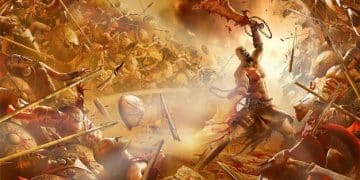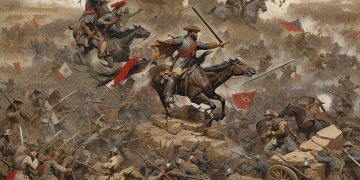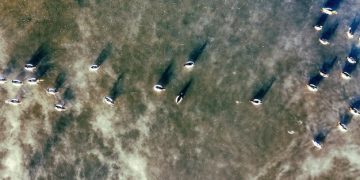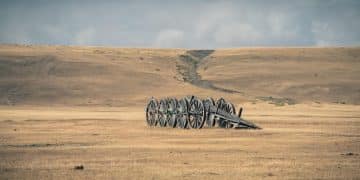The Battle of Alesia: Caesar’s Engineering Victory Explained
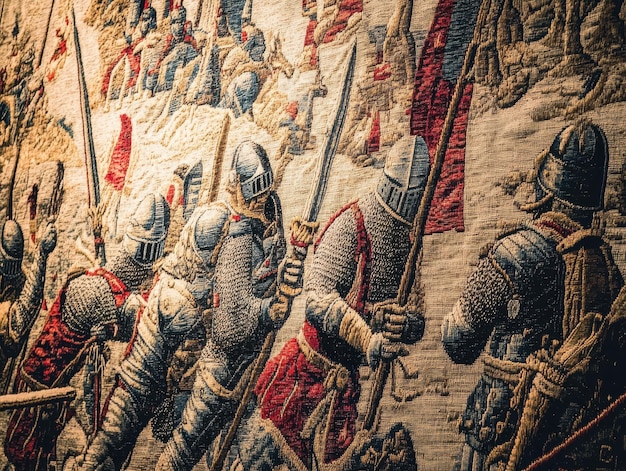
The Battle of Alesia, a pivotal clash in 52 BC, saw Julius Caesar’s victory secured through his remarkable engineering feats, including the construction of extensive fortifications that both besieged the Gallic town and defended his army from external relief forces.
The Battle of Alesia: How Did Caesar’s Engineering Prowess Secure Victory? remains a testament to Roman military ingenuity and Caesar’s strategic brilliance. In 52 BC, during the Gallic Wars, Caesar faced a formidable challenge in the form of Vercingetorix, leader of the Gallic tribes.
The Siege of Alesia: A Clash of Civilizations
The siege of Alesia wasn’t just a battle; it was a complex strategic undertaking that showcased Caesar’s understanding of both military tactics and engineering. The Gauls, under Vercingetorix, had retreated to Alesia, a fortified settlement, hoping to withstand a Roman siege. However, they underestimated Caesar’s determination and his army’s capabilities.
Vercingetorix’s Stand at Alesia
Vercingetorix’s decision to entrench himself at Alesia was strategic, hoping to draw Caesar into a protracted siege and weaken his forces. The Gauls believed the fortifications and their own fighting spirit would be enough to hold off the Romans until reinforcements arrived.
Caesar’s Response: A Double Investment
Caesar’s plan was audacious: to not only besiege Alesia but also to protect his forces from a potential Gallic relief army. He ordered the construction of two sets of fortifications – one to encircle Alesia and another to defend against external attacks.
- Circumvallation: An inner ring of fortifications to contain the besieged Gauls within Alesia.
- Contravallation: An outer ring of fortifications to protect the Roman army from Gallic reinforcements.
- Ingenious Traps: Hidden obstacles and traps to further deter attackers.
The sheer scale and complexity of Caesar’s engineering works were unprecedented, demonstrating the advanced capabilities of Roman military engineering. This investment was pivotal in securing victory against a numerically superior Gallic force.

In summary, the beginning of the battle involved more than just warring factions. Caesar displayed military prowess by using intricate military tactics and engineering for a calculated victory.
The Engineering Marvel: Fortifications Unveiled
The Roman fortifications at Alesia weren’t merely defensive walls; they were a sophisticated system of interconnected structures designed to withstand a variety of attacks. Caesar’s detailed account in *De Bello Gallico* provides invaluable insights into the construction and purpose of these fortifications.
Components of the Roman Fortifications
The fortifications comprised several key elements, each designed to serve a specific purpose in the overall defensive strategy. These elements worked together seamlessly to create a formidable barrier that proved impenetrable to the Gallic forces.
Construction Methodology and Materials
The Romans employed a systematic approach to construction, utilizing readily available materials and skilled labor. The efficiency and speed with which they built these fortifications were remarkable, given the scale of the project and the constant threat of attack.
- Ditches and Moats: Deep trenches filled with water or sharpened stakes to hinder enemy advances.
- Ramparts and Walls: Elevated earthworks reinforced with timber and topped with palisades for defensive positions.
- Towers and Redoubts: Strategically placed observation posts and strongholds for archers and artillery.
- Hidden Traps: Concealed pits and obstacles to surprise and disorient attackers.
The Romans fortified the walls of Alesia with a mixture of ditches, towers and hidden traps to impair incoming Gauls.
Collectively, Alesia was a battle of wills, as Caesar used these structures to overcome Gauls led by Vercingetorix.
Caesar’s Innovative Military Tactics: Beyond Engineering
While the engineering feats at Alesia were impressive, Caesar’s success also stemmed from his innovative military tactics. He was a master of strategy and adaptation, constantly adjusting his plans to exploit enemy weaknesses and maximize his own strengths.
Exploiting Gallic Weaknesses
Caesar understood the internal divisions and rivalries among the Gallic tribes. He used this knowledge to his advantage, playing one tribe against another and preventing them from uniting against him. This divide-and-conquer approach was crucial to his success in Gaul.
Maintaining Supply Lines
Logistics were a critical factor in any ancient military campaign. Caesar meticulously managed his supply lines, ensuring his troops were well-fed and equipped throughout the siege. He established secure routes for transporting provisions and maintained a reserve supply in case of disruptions.
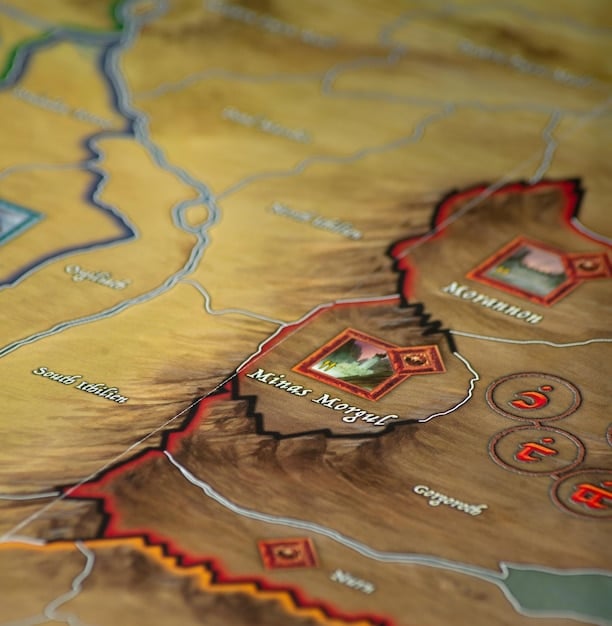
Caesar used tactics from Gallic weaknesses to his military forces.
Caesar used his military mastery to secure his place in history.
The Gallic Relief Effort: A Race Against Time
As the siege of Alesia dragged on, the Gallic tribes rallied to send a relief army to break the Roman encirclement. This force, numbering in the tens of thousands, posed a serious threat to Caesar’s army. The Gauls recognized the importance of Alesia and were determined to rescue Vercingetorix and his men.
Challenges Faced by the Relief Army
The Gallic relief army faced numerous challenges, including coordinating the efforts of diverse tribes, overcoming Roman defenses, and maintaining morale in the face of a well-disciplined Roman army. They also lacked a unified command structure, which hampered their ability to execute complex maneuvers.
Clashes and Skirmishes
The arrival of the relief army led to a series of intense clashes and skirmishes around the Roman fortifications. The Gauls launched repeated assaults, attempting to breach the Roman lines and reach Alesia. However, the Romans stood firm, repelling each attack with superior tactics and discipline.
- Night Attacks: Gallic attempts to exploit the cover of darkness to infiltrate the Roman lines.
- Siege Warfare: Use of siege engines and scaling ladders to attack the Roman walls.
- Cavalry Raids: Gallic cavalry harassing Roman supply lines and scouting positions.
The Gauls displayed their perseverance to keep trying to reach Alesia during this race against time.
However, the Romans used tactics and sheer will to hold them off.
The Decisive Battle: Roman Engineering Triumphs
The climax of the siege came with a decisive battle that pitted the Roman army against the combined forces of the besieged Gauls and the relief army. Caesar’s engineering prowess played a crucial role in securing victory, as the Roman fortifications proved to be an insurmountable obstacle for the Gauls.
Breaking the Gallic Assault
The Gauls launched a coordinated assault on the Roman lines, attempting to overwhelm the defenders with sheer numbers. However, the Roman fortifications held strong, and the Roman soldiers fought with unwavering courage and discipline. Caesar’s leadership and tactical acumen inspired his troops to stand firm.
Caesar’s Strategic Maneuvers
Caesar skillfully maneuvered his troops to counter the Gallic attacks, exploiting weaknesses in their formations and launching counterattacks at opportune moments. He used his cavalry to harass the enemy flanks and disrupt their lines of communication. His ability to anticipate enemy movements and react decisively proved to be a decisive advantage.
Ultimately, Caesar’s army triumphs, and he comes out victorious.
His name is etched in history as a military leader.
Alesia’s Legacy: Engineering and Military Doctrine
The Battle of Alesia had a profound impact on Roman military doctrine and engineering practices. The lessons learned during the siege were incorporated into future campaigns, and the engineering techniques employed at Alesia became standard practice for Roman armies. Alesia became a symbol of Roman military prowess and engineering innovation.
Influence on Future Campaigns
Caesar’s success at Alesia inspired future Roman generals to adopt similar strategies and tactics. The use of elaborate fortifications, combined with skillful maneuvering and disciplined troops, became a hallmark of Roman military campaigns. Alesia set a new standard for siege warfare and demonstrated the importance of engineering in military operations.
Advancements in Military Engineering
The construction of the fortifications at Alesia led to significant advancements in Roman military engineering. Roman engineers refined their techniques for building walls, towers, and other defensive structures. They also developed new tools and equipment to improve efficiency and speed of construction. The engineering innovations at Alesia contributed to the overall success of the Roman military machine.
The name and stories of Alesia were passed down across the ages.
It highlights a point in time where a leader used his prowess to be victorious.
| Key Point | Brief Description |
|---|---|
| 🛡️ Strategic Siege | Caesar besieged Alesia while constructing fortifications against external threats. |
| 🚧 Engineering Marvel | Roman fortifications included ditches, ramparts, and hidden traps. |
| ⚔️ Gallic Relief | Gallic tribes attempted to break the siege with a relief army. |
| 🏛️ Lasting Impact | Alesia influenced Roman military doctrine and engineering practices. |
Frequently Asked Questions
▼
The Battle of Alesia marked a crucial victory for Julius Caesar in the Gallic Wars, solidifying his control over Gaul (modern-day France) and enhancing his political power in Rome.
▼
Caesar’s innovative design implemented the double wall around Alesia, ensuring the troops would not be attacked from the inside, and providing protection outside from potential relief forces.
▼
The siege of Alesia lasted for about a month in 52 BC, making it a relatively short, but decisive, campaign in the Gallic Wars.
▼
Yes, Romans are known for creating military tactics and planning attacks. This was one amongst many throughout the Roman empire.
▼
Julius Caesar’s account, *De Bello Gallico*, is a primary source. Many books and documentaries offer detailed analyses and historical context for better understanding.
Conclusion
In summary, The Battle of Alesia: How Did Caesar’s Engineering Prowess Secure Victory? stands as a testament to the power of engineering and strategic thinking in warfare. Caesar’s innovative fortifications and tactical acumen enabled him to overcome a numerically superior enemy and secure a decisive victory that shaped the course of Roman history. The legacy of Alesia continues to inspire military leaders and engineers to this day.
